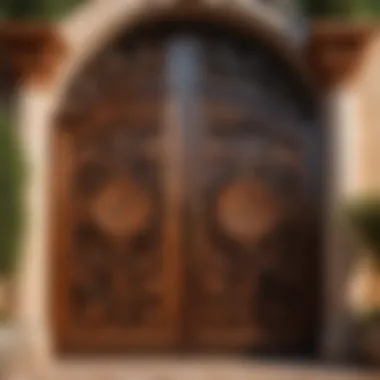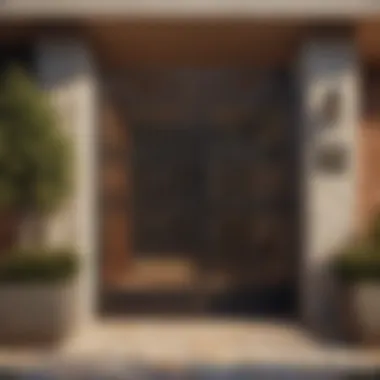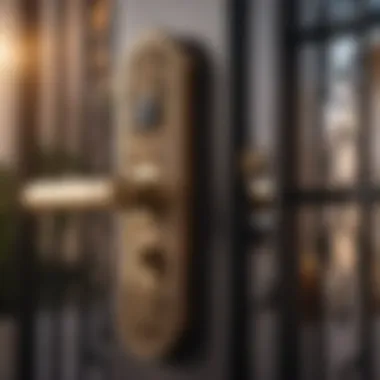Materials:
-
Wooden Gate Panels: (Quantity - 1) - Each panel measuring 6 feet in height and 3 feet in width, constructed from durable cedar wood to ensure longevity and resistance to weather conditions.
-
Metal Gate Hinges and Latches: (Quantity - 2 sets) - High-quality stainless steel hinges and latches for secure attachment and smooth operation of the gate.
-
Wood Posts: (Quantity - 2) - Sturdy 4x4 inch cedar posts to support the gate structure and provide stability.
-
Concrete Mix: (Quantity - 2 bags) - To secure the posts into the ground firmly and prevent shifting.
-
Level: Ensure precise alignment of the gate during installation.
-
Measuring Tape: To accurately measure distances and ensure proper dimensions for a perfect fit.
-
Screwdriver and Screws: For attaching gate panels, hinges, and latches securely.
-
Safety Gear: Gloves and goggles for protection during construction.
DIY Steps:
-
Planning and Design: Measure the space for the gate, consider the style and height needed for security and aesthetics.
-
Marking and Digging: Use markers to outline the placement of the gate and dig holes for the posts, ensuring they are deep enough for stability.
-
Installing Posts: Place the posts in the holes, make sure they are level, fill with concrete mix, and allow time to set.
-
Attaching Gate Panels: Connect the gate panels to the posts using hinges, ensuring they swing open and close smoothly.
-
Adding Latches and Finishing Touches: Install latches for security and test the gate for smooth operation.
Technical Aspects:
-
Timing: Allow at least a weekend to complete the project, considering drying times for concrete.
-
Tools: Besides the listed materials, a hammer and nails might also be necessary for additional fastening.
-
Critical Techniques: Ensure proper alignment and levelness throughout the installation process to avoid issues later.
DIY Project Process:


-
Step-by-step Installation Method:
- Start by positioning the first gate panel against the post, ensuring it aligns correctly before attaching hinges.
- Repeat the process for the second gate panel, ensuring both are symmetrical and secure.
-
Highlighting Key Techniques:
- Double-check measurements and alignment at each step to prevent errors that can compromise the gate's functionality.
-
Troubleshooting Tips:
- If the gate sticks or doesn't close properly, adjust the hinges or latches for a better fit.
- In case of post instability, add more concrete mix and allow it to set before testing the gate again.
This detailed guide provides a comprehensive overview of the materials needed, step-by-step instructions, technical aspects, and troubleshooting tips for a successful installation of a new side gate, ensuring security, aesthetics, and functionality for your home.
Introduction


In the realm of enhancing the security and aesthetic appeal of residential properties, the installation of a new side gate holds significant importance. As homeowners seek to fortify their property boundaries and elevate the overall look of their exteriors, the side gate stands out as a focal point. This article will delve into every crucial aspect related to the installation of a new side gate, ranging from security considerations to design aesthetics and legal obligations.
Importance of a Side Gate
A side gate serves as a crucial element in transforming a house into a secure and visually appealing sanctuary. The significance of a side gate cannot be understated, as it acts as the first line of defense against intruders while simultaneously enhancing the curb appeal of the property. From a security standpoint, a sturdy side gate provides a sense of privacy and protection, dissuading potential trespassers and safeguarding the property from unauthorized access.
Moreover, beyond its security function, a side gate adds a touch of elegance and sophistication to the exterior of the house. By selecting a design that complements the architectural style of the home, homeowners can elevate the overall visual aesthetics of their property. The side gate serves as a seamless blend of functionality and style, creating a harmonious balance between security requirements and design preferences.
Understanding the importance of a side gate involves recognizing its dual role as a security enhancement and a visual enhancement. This aspect underscores the significance of choosing the right materials, design, and installation method to ensure that the side gate fulfills both functional and aesthetic purposes effectively.
Planning Phase


The Planning Phase is a critical aspect when considering the installation of a new side gate for a house. It sets the foundation for a successful project by outlining key elements that need to be addressed before moving forward. One of the primary reasons why the Planning Phase is crucial is that it allows homeowners to clearly define their objectives and requirements for the side gate installation. By taking the time to plan effectively, individuals can ensure that the gate meets their expectations in terms of functionality, security, and aesthetics.
When delving into the Planning Phase, it is essential to consider specific elements that will guide decision-making throughout the project. These include determining the purpose of the side gate, setting a realistic budget, and researching local regulations to ensure compliance. Each of these components plays a vital role in the overall success of the installation process.
Determining the Purpose
In the Determining the Purpose stage of the Planning Phase, homeowners need to establish why they are installing a side gate. Is it primarily for security reasons, to enhance the curb appeal of the property, or a combination of both? By clarifying the primary purpose of the gate, individuals can tailor their choices in terms of materials, design, and additional features to align with their specific goals.
Setting a Budget
Setting a budget is a crucial step during the Planning Phase as it helps homeowners understand the financial implications of the project. By determining how much they are willing to invest in the side gate installation, individuals can make informed decisions regarding the materials to be used, whether to opt for professional installation or pursue a DIY approach, and any additional features such as automation.
Researching Regulations
Researching local regulations is a non-negotiable aspect of the Planning Phase when installing a new side gate. Understanding zoning laws, property boundaries, and any restrictions related to gate height or design is essential to avoid potential legal issues in the future. By conducting thorough research early in the planning process, homeowners can ensure that their side gate complies with all necessary regulations, giving them peace of mind and preventing costly violations down the road.
Selecting Materials
When it comes to selecting materials for your new side gate, this decision holds significant importance in the overall outcome of your project. The material you choose will not only determine the gate's aesthetics but also its functionality and durability. It's crucial to consider factors such as weather resistance, maintenance requirements, security needs, and the overall style of your home.
Wooden Gates
Wooden gates offer a classic and natural look that can enhance the charm of your property. They are versatile in design, allowing for customization to match your home's architecture. However, wooden gates require regular maintenance to prevent rotting, warping, and pests infestation. It's essential to use high-quality, rot-resistant wood like cedar or redwood for longevity. Additionally, consider staining or treating the wood to prolong its lifespan and maintain its appearance.
Metal Gates
Metal gates are a popular choice for their durability and security features. They require minimal maintenance compared to wooden gates and are excellent for high-traffic areas. Materials such as steel, wrought iron, or aluminum offer varying levels of strength and aesthetics. Steel gates are sturdy but prone to rust, while aluminum gates are lightweight and resistant to corrosion. Wrought iron gates provide a traditional and elegant look but may require occasional repainting to prevent rust.
Composites and PVC
Composites and PVC gates are modern alternatives that combine the aesthetics of wood with the low maintenance of synthetic materials. Composite gates are made from a blend of wood fibers and recycled plastic, offering the look of wood without the upkeep. PVC gates are lightweight, durable, and resistant to rot, insects, and warping. They are available in various colors and styles to suit different architectural themes. Consider these options if you desire the appearance of wood without the maintenance requirements.
Considering Automation
Automation adds convenience and security to your gate system by allowing for remote access and control. When selecting materials, it's essential to choose ones compatible with automation components like motors, sensors, and remote controls. Metal gates are often preferred for automation due to their sturdy frame and support for electronic mechanisms. Keep in mind that automation systems require professional installation to ensure proper functionality and safety. Factor in the additional cost of automation components when budgeting for your new side gate project.
Design Considerations
Design considerations play a crucial role in the process of installing a new side gate for your home. It is essential to carefully assess various aspects to ensure that the gate not only fits the practical needs of security but also complements the overall aesthetic appeal of your property. By focusing on design considerations, you can achieve a harmonious blend of functionality and style, adding value to your home.
When selecting a side gate, you should pay attention to details such as the architectural style of your house, existing outdoor elements, and the overall vibe you want to create. By matching the gate to your home's style, you can create a cohesive look that enhances the curb appeal and overall attractiveness of your property.
Moreover, design considerations extend beyond just visual appeal. Enhancing security through smart design choices is crucial. Opt for sturdy materials, reliable locking mechanisms, and height specifications that deter intruders. Integrating security features seamlessly into the design ensures that your gate not only looks good but also serves its primary purpose of safeguarding your home and loved ones.
Installation Options
When it comes to exploring the installation options for a new side gate, it's crucial to consider various factors that can greatly impact the outcome of your project. The choice between professional installation and a do-it-yourself approach can significantly influence the gate's quality, durability, and overall aesthetic appeal. Understanding the specific elements, benefits, and considerations of each installation option is essential for making an informed decision.
Professional Installation
Opting for professional installation offers several distinct advantages. Firstly, professional installers have the expertise and experience to ensure that the gate is correctly fitted and functions optimally. They can provide valuable insights into the best placement for the gate, taking into account factors such as security, convenience, and curb appeal. Additionally, professionals have access to specialized tools and equipment, ensuring a precise and efficient installation process.
Furthermore, professional installation typically comes with warranties or guarantees, providing you with peace of mind knowing that any potential issues will be promptly addressed. While the initial cost of professional installation may be higher than a DIY approach, the long-term benefits in terms of durability, reliability, and overall satisfaction make it a worthwhile investment. By entrusting your side gate installation to skilled professionals, you can achieve a seamless and professional outcome that enhances both the security and visual appeal of your property.
DIY Installation
On the other hand, embarking on a do-it-yourself installation can be a rewarding and cost-effective option for homeowners with a knack for construction and craftsmanship. DIY installations allow for greater personalization and customization, giving you full control over the design and execution of the project. It can be a fulfilling experience to see your vision come to life through your own efforts and creativity.
However, DIY installations require careful planning, precise measurements, and meticulous attention to detail to ensure a successful outcome. Without the expertise and tools of professional installers, DIY projects can present challenges and potential pitfalls that may compromise the gate's functionality and durability. It's essential to follow manufacturer's instructions diligently, use high-quality materials, and take necessary safety precautions throughout the installation process.
Ultimately, whether you opt for professional installation or choose to tackle the project yourself, make sure to weigh the pros and cons of each approach carefully. Consider your skill level, available time, budget, and desired outcome to determine the most suitable installation option for your new side gate.
Legal and Permit Considerations
When embarking on the installation of a new side gate for your house, diving into the legal and permit considerations is crucial. Understanding the regulations and requirements set forth by local authorities can save you from potential fines, violations, or the need to remove your newly installed gate. It is essential to adhere to these rules not only for compliance but also for ensuring the safety and functionality of your gate.
One of the primary elements to consider within legal and permit considerations is zoning regulations. These regulations dictate where and how structures like gates can be installed on your property. This includes aspects such as distance from the property line, height restrictions, and even design aesthetics that need to align with the neighborhood's architectural style. By familiarizing yourself with these regulations, you can avoid costly mistakes and delays in your project.
Additionally, obtaining the necessary permits is often a prerequisite before installing a new side gate. Permits ensure that your project meets safety standards and is in line with local building codes. Failure to acquire the proper permits can result in penalties or having to dismantle the gate altogether. Therefore, it is imperative to check with your local building department or authorities to determine the specific permits required for your gate installation.
Considering the benefits of navigating legal and permit considerations, it not only guarantees a smooth installation process but also provides peace of mind knowing that your gate complies with all legal requirements. By addressing these aspects proactively, you can enjoy your new gate without any hindrances or legal implications, enhancing both the functionality and value of your property.
Checking Local Regulations
Focusing specifically on checking local regulations when installing a new side gate is paramount to the success of your project. Local regulations vary from one area to another, and understanding the specific guidelines applicable to your property is crucial to avoid any complications down the line.
Start by researching the zoning laws in your locality. These laws outline the allowable land use, including the installation of structures like gates. Pay attention to any restrictions related to gate height, material, and distance from the property line. Compliance with these regulations ensures that your new gate meets the standards set by the local authorities.
Moreover, be mindful of any homeowners' association (HOA) requirements that may exist in your neighborhood. HOAs often have strict guidelines regarding property modifications, including the installation of gates. It is essential to review these guidelines and seek approval if necessary to prevent any violations or disputes.
By thoroughly investigating and adhering to local regulations, you can proceed with confidence in your side gate installation project. Ensuring compliance with these regulations not only keeps you on the right side of the law but also contributes to the seamless integration of your new gate into your property, elevating its aesthetics and functionality.
Maintenance and Care
Maintaining and caring for your new side gate is crucial to ensure its longevity, functionality, and aesthetics. In this section, we will delve into the specific elements, benefits, and considerations related to maintaining and caring for your side gate.
Regular Cleaning
Regular cleaning is a fundamental aspect of gate maintenance. With exposure to various elements like dust, dirt, and pollution, regular cleaning not only keeps your gate looking its best but also prevents deterioration.
To begin, create a cleaning schedule based on your gate's material. Wooden gates may require different cleaning products and methods than metal or composite gates. Consult your gate manufacturer's instructions for specific cleaning recommendations.
Start by removing surface debris with a soft brush or cloth. Next, lightly spray the gate with water to loosen dirt and grime. Use a mild detergent or gate-specific cleaner to scrub the surface gently. Rinse thoroughly with clean water to prevent any residue build-up.
For metal gates, it's crucial to inspect for rust or corrosion during the cleaning process. Address any rust spots promptly by sanding the affected areas, applying a rust inhibitor, and repainting to protect the metal.
After cleaning, ensure the gate is completely dry before applying any protective coatings or sealants. For wooden gates, consider reapplying a coat of sealant or varnish to protect against moisture and UV damage.
Regularly inspect the gate's hinges, latches, and moving parts for any signs of wear or malfunction. Lubricate hinges and moving components to maintain smooth operation.
Enhancing Property Value
When considering the installation of a new side gate for your house, one cannot overlook the significant impact it can have on the property value. Enhancing property value is a crucial aspect to address, as it goes beyond just the immediate benefits of security and aesthetics. By investing in a well-designed and secure side gate, you are not only improving the functionality and visual appeal of your property but also increasing its overall worth.
To enhance the property value through the installation of a side gate, several key elements need to be taken into account. Firstly, the material and design of the gate play a vital role in boosting the curb appeal and perceived value of your home. Opting for high-quality materials such as wrought iron, aluminum, or premium wood can elevate the overall look of your property and leave a lasting impression on potential buyers or visitors.
Additionally, the craftsmanship and installation of the side gate are paramount. A professionally installed gate that aligns seamlessly with the architectural style of your house can add a touch of sophistication and elegance, further increasing the property's desirability and value in the real estate market.
Moreover, the functionality and security features of the gate can also contribute to enhancing property value. Automated gates with advanced security systems not only offer convenience but also make your property more attractive to prospective buyers seeking modern amenities and safety measures.





